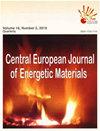Study on the Thermal Stability and Decomposition Kinetics of Polypropylene Glycol - Glycidyl Azide Polymer - Polypropylene Glycol (PPG-GAP-PPG) as a Novel Triblock Copolymer Binder
IF 0.6
4区 工程技术
Q4 CHEMISTRY, APPLIED
引用次数: 3
Abstract
In this study, the novel energetic triblock copolymer of polypropylene glycolglycidyl azide polymerpolypropylene glycol (PPG-GAP-PPG) (Mn = 1419 g·mol–1) was synthesized by cationic ring-opening polymerization of propylene oxide using low molecular weight glycidyl azide polymer (GAP) (Mn = 1006 g·mol–1) as the initiator and boron trifluoride etherate (BF3·OEt2) as the catalyst. The synthesized GAP and triblock copolymer were characterized by Fourier-transform infrared (FT-IR) spectroscopy, gel permeation chromatography (GPC), and nuclear magnetic resonance spectroscopy (1H and 13C NMR). The thermal stability of the triblock copolymer PPG-GAP-PPG was studied by differential scanning calorimetry (DSC) and thermogravimetry (TG). The DSC results showed that the glass transition temperature (Tg) of the triblock copolymer (Tg = −63 °C) was lower than that of neat low molecular weight GAP (Tg = −53 °C). Furthermore, the results indicated that this triblock copolymer is more stable than GAP. The influence of heating rate (10, 20, 30 and 40 °C·min−1) illustrated that increasing the heating rate results in an increase in the triblock copolymer’s decomposition temperature. Non-isothermal methods, proposed by ASTM E698, Flynn-Wall-Ozawa (FWO) and Kissinger, were used to calculate the kinetic parameters, such as activation energy and frequenc factor, for the thermal decomposition of the triblock copolymer PPG-GAP-PPG, using the DSC-DTG Central European Journal of Energetic Materials ISSN 1733-7178; e-ISSN 2353-1843 Copyright © 2020 Łukasiewicz Research Network – Institute of Industrial Organic Chemistry, Poland 263 Study on the Thermal Stability and Decomposition Kinetics... Copyright © 2020 Łukasiewicz Research Network – Institute of Industrial Organic Chemistry, Poland data. The activation energies calculated by the FWO and ASTM E698 methods were 124.610 and 126.13 kJ·mol–1, respectively.新型三嵌段共聚物粘结剂丙二醇-叠氮缩水甘油酯聚合物-丙二醇(PPG-GAP-PPG)的热稳定性及分解动力学研究
本研究以低分子量叠氮缩水甘油酯聚合物(GAP)(Mn=1006 g·mol–1)为引发剂,三氟化硼醚化物(BF3·OEt2)为催化剂,通过环氧丙烷的阳离子开环聚合,合成了聚丙烯-乙醇-叠氮缩水缩水甘油酯-聚丙二醇的新型高能三嵌段共聚物(PPG-GAP-PPG)(Mn=1419 g·mol-1)。通过傅立叶变换红外光谱(FT-IR)、凝胶渗透色谱(GPC)和核磁共振波谱(1H和13C NMR)对合成的GAP和三嵌段共聚物进行了表征。采用差示扫描量热法(DSC)和热重分析法(TG)研究了三嵌段共聚物PPG-GAP-PPG的热稳定性。DSC结果表明,三嵌段共聚物的玻璃化转变温度(Tg=−63°C)低于纯低分子量GAP的玻璃化转化温度(Tg=−53°C)。此外,结果表明,该三嵌段共聚物比GAP更稳定。加热速率(10、20、30和40°C·min−1)的影响表明,增加加热速率会导致三嵌段共聚物的分解温度升高。使用ASTM E698、Flynn Wall Ozawa(FWO)和Kissinger提出的非等温方法,使用DSC-DTG《中欧高能材料杂志》ISSN 1733-7178,计算了三嵌段共聚物PPG-GAP-PPG热分解的动力学参数,如活化能和频率因子;e-ISSN 2353-1843版权所有©2020Łukasiewicz研究网络-波兰工业有机化学研究所263热稳定性和分解动力学研究。。。版权所有©2020Łukasiewicz研究网络-波兰工业有机化学研究所数据。FWO和ASTM E698方法计算的活化能分别为124.610和126.13 kJ·mol–1。
本文章由计算机程序翻译,如有差异,请以英文原文为准。
求助全文
约1分钟内获得全文
求助全文
来源期刊

Central European Journal of Energetic Materials
CHEMISTRY, APPLIED-ENGINEERING, CHEMICAL
CiteScore
1.80
自引率
25.00%
发文量
0
审稿时长
>12 weeks
期刊介绍:
CEJEM – the newest in Europe scientific journal on energetic materials It provides a forum for scientists interested in the exchange of practical and theoretical knowledge concerning energetic materials: propellants, explosives and pyrotechnics. The journal focuses in particular on the latest results of research on various problems of energetic materials.
Topics:
ignition, combustion and detonation phenomenon;
formulation, synthesis and processing;
analysis and thermal decomposition;
toxicological, environmental and safety aspects of energetic materials production, application, utilization and demilitarization;
molecular orbital calculations;
detonation properties and ballistics;
biotechnology and hazards testing
CEJEM presents original research and interesting reviews. Contributions are from experts in chemistry, physics and engineering from leading research centers in Europe, America and Asia. All submissions are independently refereed by Editorial Board members and by external referees chosen on international basis.
 求助内容:
求助内容: 应助结果提醒方式:
应助结果提醒方式:


